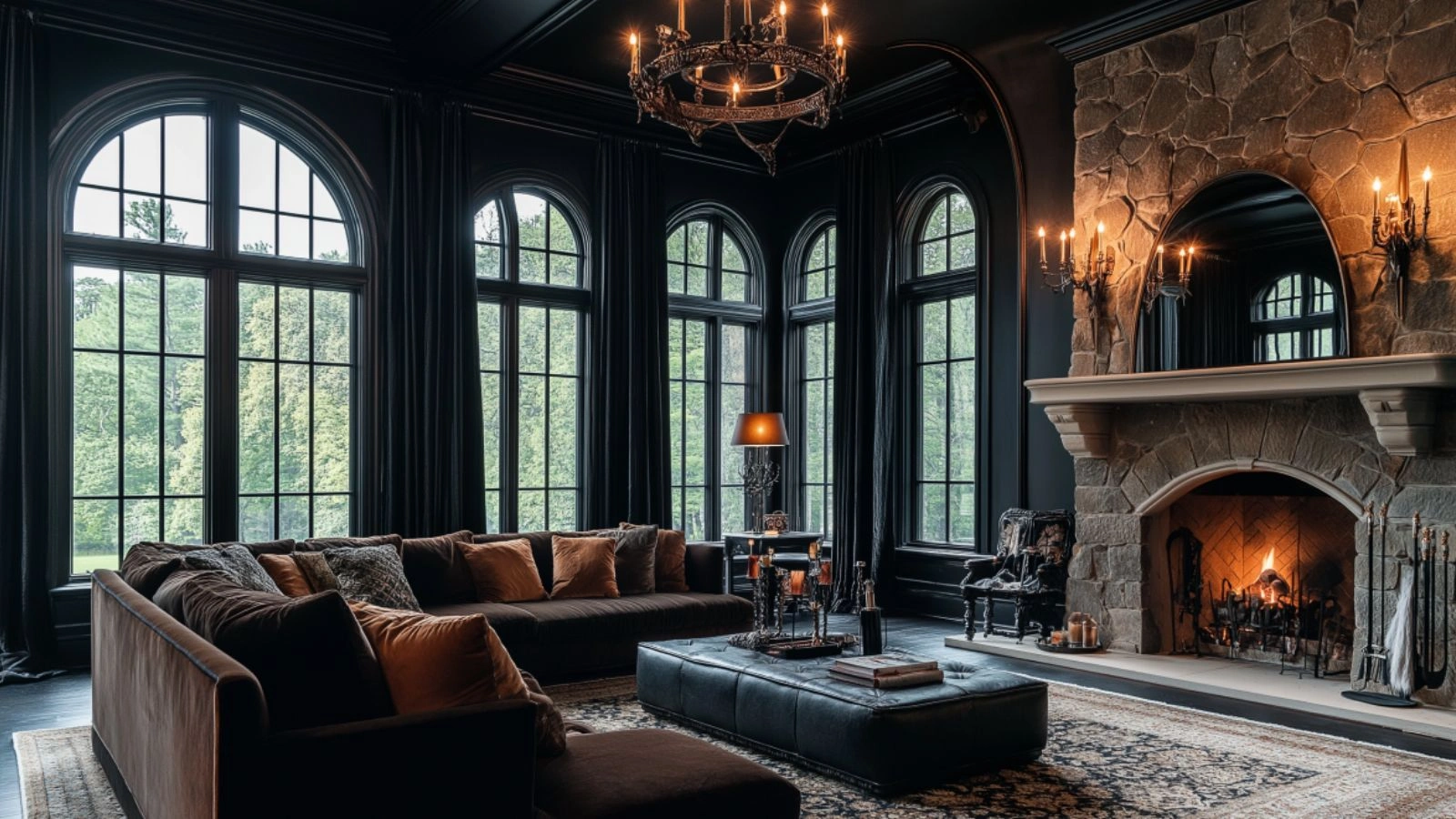Transform Your Home with These 6 Gothic Living Room Ideas for Bold, Dramatic Style
Table of Contents
Looking to infuse your home with drama, elegance, and a sense of mystique? Gothic living room design might be the bold style shift you’ve been craving. This timeless aesthetic blends dark romanticism with intricate details, moody tones, and architectural charm—making your living room feel more like a castle chamber than a cookie-cutter space.
In recent years, there’s been a cultural resurgence in dark and dramatic interiors. Pinterest searches for “gothic living room ideas” have spiked, and home decor influencers are embracing the bold beauty of black walls, antique furniture, and velvet textures. Why? Because gothic design isn’t just edgy—it’s layered, expressive, and surprisingly cozy when done right.
In this post, we’ll explore six captivating gothic living room ideas to help you transform your space. Whether you want to go full Victorian revival or subtly nod to the style with a few ornate accents, you’ll find inspiration that fits your taste and your home. From statement furniture to moody lighting and rich textures, each section offers practical tips and visual examples to help you bring your gothic vision to life.
Start with a Dark and Dramatic Color Palette
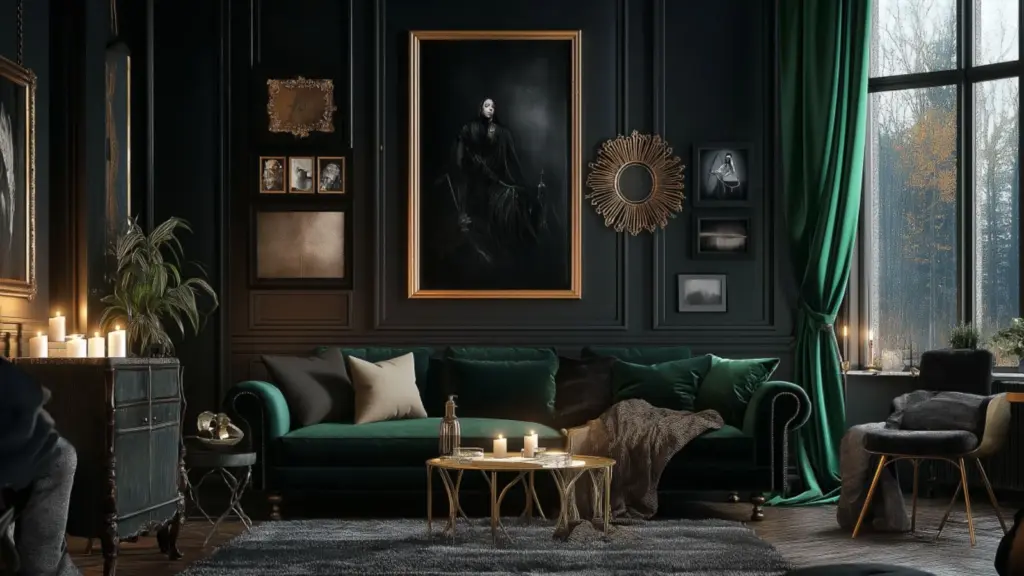
Color is the foundation of gothic design. Deep, saturated hues like charcoal, eggplant, forest green, and oxblood red instantly set a moody and luxurious tone. Black, of course, is the signature shade of the style—but it doesn’t have to feel flat or oppressive. Used thoughtfully, black can create a cozy cocoon that enhances everything else in the room.
If you’re worried about the space feeling too dark, balance it with natural light, mirrors, or lighter-toned accents like antique gold, pewter, or ivory. You can also use different finishes—matte, gloss, velvet, or stone—to create depth within the color palette.
Table: Gothic Color Palette Ideas
| Primary Color | Accent Pairings | Mood It Creates |
|---|---|---|
| Matte Black | Antique gold, burgundy | Bold, regal, mysterious |
| Oxblood Red | Charcoal gray, brass | Dramatic, warm, vintage |
| Deep Plum | Soft ivory, velvet black | Romantic, rich, sophisticated |
| Emerald Green | Aged bronze, walnut wood | Earthy, lush, opulent |
Choose Statement Gothic Furniture with Ornate Details
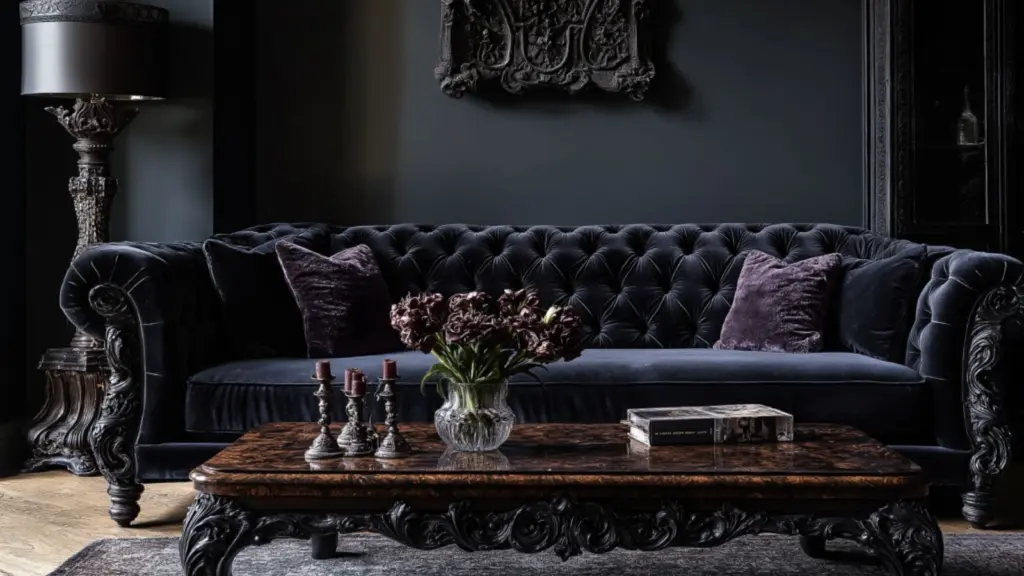
The right furniture can anchor your gothic living room and instantly communicate the style. Gothic-inspired furniture is typically grand and embellished, often featuring carved wood, clawfoot legs, tufted upholstery, and dramatic silhouettes.
Start with a central piece like a Victorian-style sofa in velvet or leather. Dark woods such as mahogany or walnut work beautifully for coffee tables and bookcases. Look for details like scroll arms, turned legs, or iron accents. Oversized armchairs, chaise lounges, or antique settees also add authenticity and character.
To avoid overwhelming the room, pair your ornate furniture with simpler, grounding pieces like a neutral rug or clean-lined lighting fixture. Mixing modern and vintage can create a gothic-modern hybrid that feels fresh, not theatrical.
Table: Gothic Furniture Elements to Prioritize
| Furniture Piece | Gothic Features to Look For |
|---|---|
| Sofa or Loveseat | Velvet, tufting, scroll arms |
| Coffee Table | Dark wood, carved legs, iron accents |
| Bookshelves or Cabinets | Arched details, glass doors, candlelight |
| Accent Chair | High back, nailhead trim, baroque curves |
Use Architectural Accents to Create Atmosphere
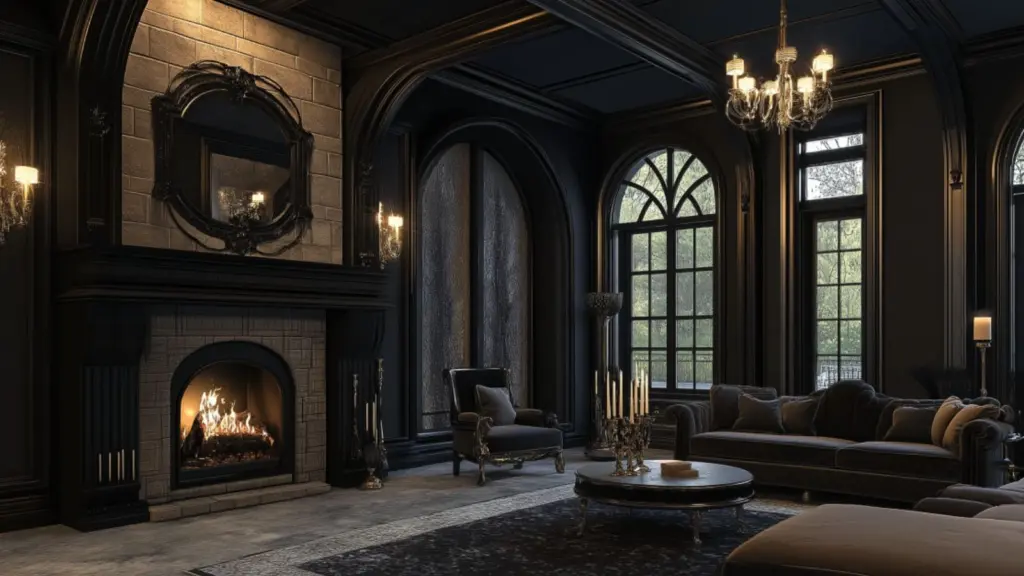
Gothic design is rooted in architecture. Incorporating architectural details—real or illusionary—can take your gothic living room from styled to immersive. Think pointed arches, columns, ceiling medallions, or even faux wall paneling.
You don’t need a medieval manor to create this effect. Decorative molding, peel-and-stick wall panels, or arched mirrors can mimic classic gothic forms. Fireplaces with stone or ornate mantelpieces are also great features for the style. Frame them with candles, wrought iron tools, or antique candelabras.
If you love DIY, consider adding faux ceiling beams or painting a trompe l’oeil arch around a doorway or window.
Checklist: Architectural Elements That Elevate Gothic Style
| Feature | How to Incorporate It |
|---|---|
| Arched shapes | Arched mirrors, bookcases, doorway trim |
| Crown molding | Paint it in contrast or black for drama |
| Fireplace surround | Use faux stone veneer or gothic metalwork |
| Wall panels | Add dimension with peel-and-stick molding |
Add Rich Textures and Layered Fabrics for Depth
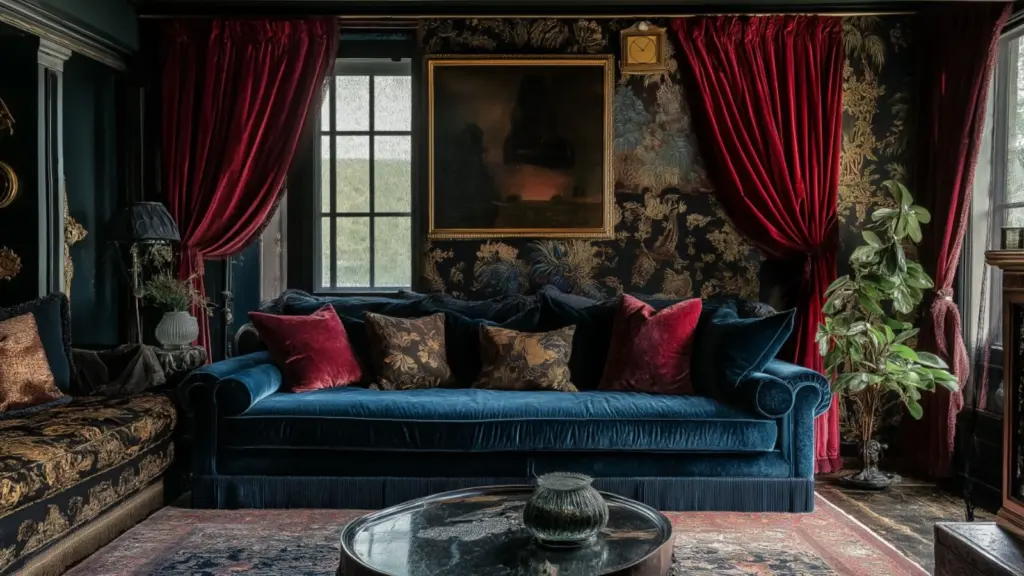
Texture is essential in gothic design, adding depth and drama through touch and tone. Velvet, leather, brocade, silk, and faux fur are all popular choices. Drape your space in luxurious materials that feel indulgent and cozy.
Start with curtains—floor-to-ceiling velvet panels in deep hues not only block light but add theatrical elegance. Layer area rugs (think Persian or oriental styles) beneath furniture to anchor the room visually. Throw pillows in embroidered, metallic, or crushed velvet fabrics can enhance the seating area.
Even your walls can add texture. Try a matte paint finish, exposed brick, or decorative wallpaper with damask or gothic motifs.
Table: Must-Have Gothic Living Room Textures
| Texture | Where to Use It |
|---|---|
| Velvet | Curtains, sofa, throw pillows |
| Brocade or Damask | Accent cushions, wallpaper |
| Leather | Armchairs, poufs, tabletop accents |
| Faux Fur | Blankets, stools, floor throws |
Set the Mood with Dim, Atmospheric Lighting
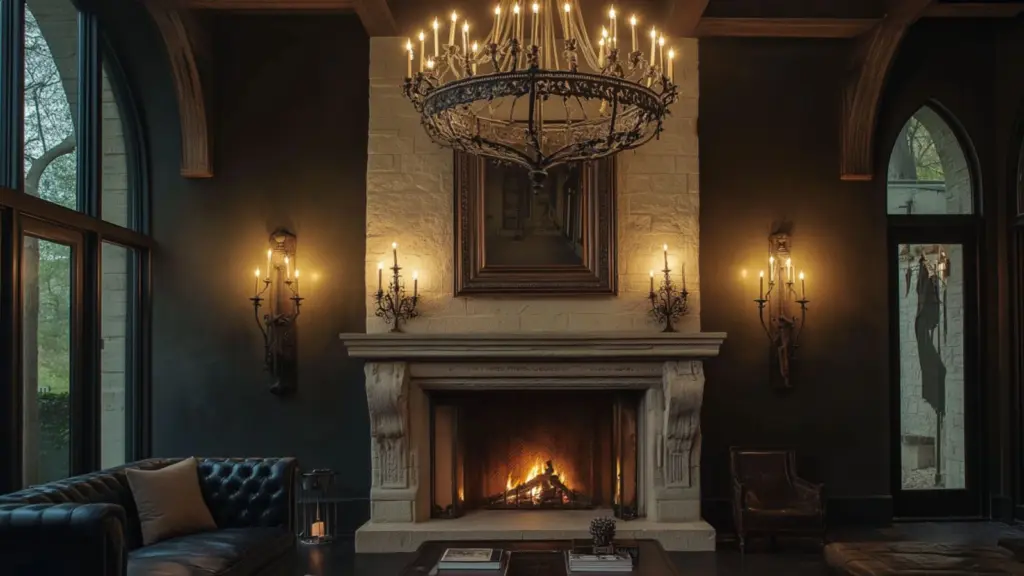
Lighting plays a crucial role in setting the gothic tone. Instead of bright overhead lights, aim for a soft, atmospheric glow that mimics candlelight and enhances the mysterious vibe of your space.
Start with a gothic-style chandelier—something in wrought iron or antique brass, ideally with candelabra bulbs. Add wall sconces and table lamps with stained glass or dark shades to create layered pools of light.
Candles are a must. Cluster tall taper candles on your mantel, or use lanterns and vintage holders to scatter soft light throughout the room. LED versions offer a safer, low-maintenance option while still delivering ambiance.
Consider smart bulbs with adjustable warmth so you can tailor the lighting to your mood or the time of day.
Table: Lighting Ideas for a Gothic Living Room
| Light Source | Best Placement | Mood Factor |
|---|---|---|
| Gothic chandelier | Ceiling centerpiece | Dramatic and classic |
| Wall sconces | Flanking fireplace or artwork | Architectural enhancement |
| Candle clusters | Mantel, shelves, side tables | Romantic and ambient |
| Table lamps | Next to seating or entry console | Soft and stylish |
Decorate with Gothic Accessories and Art
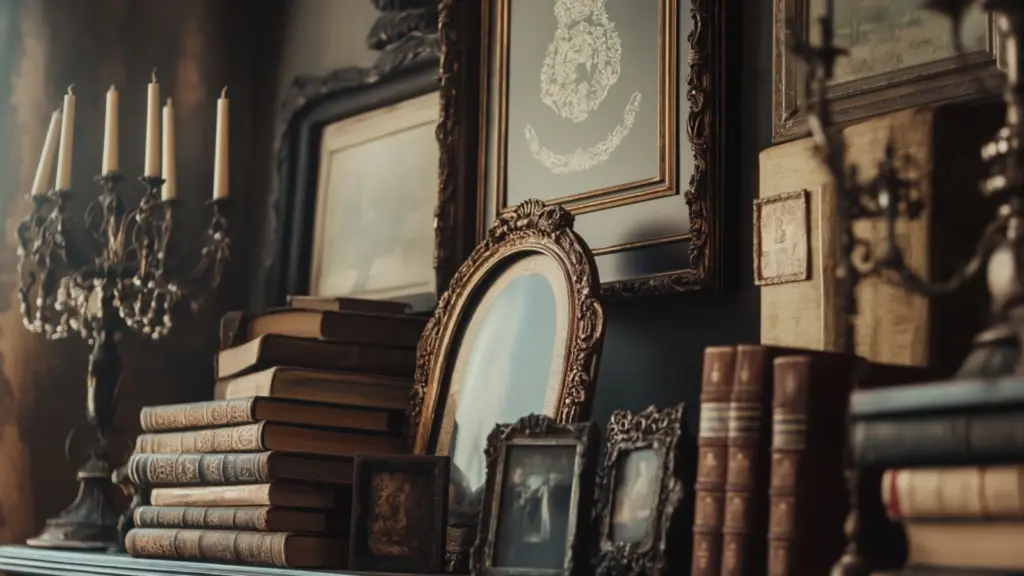
Final touches are what tie your gothic living room together. Accessories like gothic-style mirrors, antique picture frames, skull motifs, black-and-white photography, and symbolic artwork all enhance the theme.
Display collections of old books with distressed leather covers, vintage clocks, or religious iconography if you want to lean into gothic cathedral vibes. Taxidermy, old maps, or Victorian curiosities also fit beautifully.
Keep it curated—group items in odd numbers, mix heights and materials, and avoid overly themed or cluttered displays to maintain sophistication.
Visual Guide: Gothic Accessories and Styling Elements
| Accessory Type | Styling Tip |
|---|---|
| Ornate Mirrors | Use oversized mirrors to reflect candlelight |
| Vintage Books | Stack on side tables or open bookshelves |
| Framed Art or Tapestry | Choose moody or classical imagery |
| Antique Sculptures | Place on mantels, pedestals, or shelves |
Conclusion
Gothic living room design isn’t just about darkness—it’s about depth, storytelling, and timeless elegance. With rich textures, dramatic color palettes, ornate furniture, and layered lighting, you can create a space that feels both captivating and personal. Whether you fully embrace gothic revival or take a more modern, subtle approach, these six gothic living room ideas offer a roadmap for transforming your space into a sanctuary of bold beauty and mystery.
This is more than a design choice—it’s an expression of drama, history, and individuality. Done right, a gothic living room doesn’t just impress—it envelops you.

